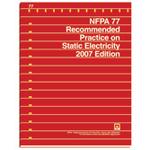
NFPA (Fire) 77
Product Details
- Published:
- 04/23/2023
- ANSI:
- ANSI Approved
- Number of Pages:
- 91
- Note:
- This product is unavailable in Ukraine, Russia, Belarus


Click here to purchase
Mitigate static electricity hazards. Help prevent ignition of flammable vapors, dust, and particulates by grounding and bonding according to the best practices in NFPA 77.
A buildup of static electricity can be a considerable hazard — it can discharge in air and ignite flammable vapors and dust. NFPA 77, Recommended Practice on Static Electricity provides important information on evaluating and controlling static electric hazards to help protect those working where these hazards can be present.
NFPA 77 offers guidance on how to:
This recommended practice covers industries as diverse as chemical processing, petroleum refining, printing, and calendaring. It includes answers to questions about properly bonding and grounding a container, and how to determine whether a static electricity hazard poses a risk.
The 2019 edition of NFPA 77 is up-to-date with referenced documents and the latest safety knowledge including:
Grounding and bonding with NFPA 77 as a guide is essential to safety in many industrial environments. (Softbound, Approx. 67 pp., 2019)

Click here to purchase
A buildup of static electricity can be a considerable hazard, as it can discharge through the air and ignite flammable vapors and dust. NFPA 77: Recommended Practice on Static Electricity provides important information on evaluating and controlling static electric hazards to help protect those working where these hazards might be present.
NFPA 77 offers guidance on how to:
This Recommended Practice covers industries as diverse as chemical processing, petroleum refining, printing, and calendaring. It includes answers to questions about properly bonding and grounding a container, and how to determine whether a static electricity hazard poses a risk.
NFPA 77 has been updated to reflect some important changes:
To prevent ignition of flammable vapors, dust, and particulates, you’ll need to get your hands on the gold standard of static electricity safety. Order NFPA 77 today.

Prevent fires and explosions with proper identification and control of static electricity using NFPA 77.
In addition to being a danger to individuals and an operating problem in industry, static electricity is often the ignition source for an ignitable mixture. Guard against fires and explosions using the latest best practices outlined in NFPA 77. You’ll access clear guidelines for the assessment of ignition potential and protocols for fire prevention.
Use NFPA 77 to mitigate risks. This document covers:
Important updates in the 2007 edition:
The document is also reorganized for clarity and consistency with NFPA’s Manual of Style.